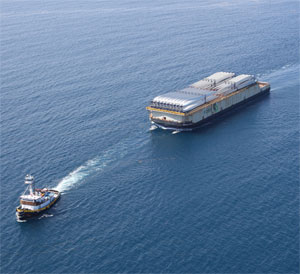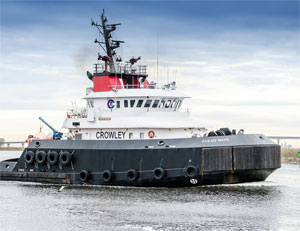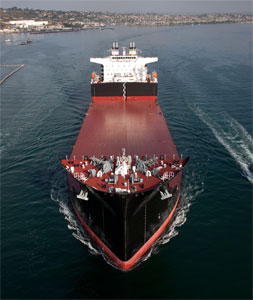As bad news continues for mariners in the Gulf of Mexico oil patch and Department of Defense shipping drops as military engagements decline, there are some bright spots for marine employment in other sectors.
While there doesn’t seem to be a single sector that has plentiful billets for the thousands of mariners who may be in the job market, hiring continues in various marine segments. So far, it’s not enough to absorb everyone looking for a job.
Small operators such as Smith Maritime, a towing operation based in Green Cove Springs, Fla., are feeling the pinch of the oil fields and lament the toll on the mariners.
“We are hanging on without the oil patch work that has been a high part of our work, and there are many times the job applicants as there were a year ago,” said Capt. Latham Smith. “These are good folks with years of steady jobs now on the street. We cannot hire them all.”
However, there are areas of job growth in the industry. Despite a drop in U.S.-flag Department of Defense cargoes to the Middle East, the Military Sealift Command (MSC), the logistics arm supporting the U.S. Navy and the Defense Department, is in expansion mode.
MSC directly employs 5,700 civil service mariners, of which 1,100 are officers and 4,600 are unlicensed, on a fleet of 55 government-owned vessels. In addition, another 70 vessels that are government owned or on long-term charter support 1,389 contract mariners employed by the vessel owners. While there are no significant changes expected for the contract side of the MSC fleet, the government-owned side expects to add mariners at a higher rate than in the recent past.
MSC has stepped up its recruiting efforts via advertising and job fairs to fill slots for new vessels.
2015 has been an aggressive hiring year with a plan to bring more than 700 civil service mariners on board. The pace will return to the normal level of about 500 new hires next year, according to Frank Cunningham, director of manpower and personnel for civilian mariners in afloat operations.
MSC has 40 open positions across all vessels, as MSC takes delivery of high-speed vessels and mobile landing platforms.
“We have a little bit of growth going on, the Navy likes the product we’re delivering,” Cunningham said.
To make hard-to-fill billets more attractive, MSC has established two part-time intermittent positions for first engineers and chief mates, two of the toughest positions for which to find candidates.
“We wanted to be more flexible in some of those ratings. Those people may not want to work full time, so we’re adding what’s basically part-time employment at that level to increase the number of resources available,” Cunningham said.
That will help give officers relief crews when their tour is up. “We’ve struggled with overdue reliefs and we’re making improvements in that area,” Cunningham said.
MSC has opened up all entry-level positions and all officer positions except for master and chief engineer. There were 18 positions open in early May. From October 2014 to May 2015, MSC received 3,300 applications compared to 900 in the same period in the previous year.
MSC has opened entry-level billets for all three tracks for civilian mariners, with ordinary seaman and wiper slots open in addition to the usual steward utility. About 1,500 of the applications are for those starter jobs.
MSC changed its hiring practices to include interviews for every position. Previously MSC conducted interviews only for applicants coming out of maritime academies. “We want to get the best new hires and rate and rank them,” Cunningham said.
He sees hiring for the petroleum-production sector falling off, with some of the larger oil-patch operators absent from recruiting at the seven academies, with MSC ready to offer jobs.
 |
|
A Foss Maritime tug tows windmill components to Puerto Rico. Foss is hiring too. |
|
Courtesy Foss Maritime |
“We’re expecting to bring on more academy grads this year than we have the last several years,” Cunningham said.
An increase in internal promotions, which will be in the 700- to 800-person range this year — compared to 400 to 500 per year on average — is opening up entry-level slots.
“As the number of ships has increased we have more promotions to fill,” Cunningham said.
The towing and project sectors are holding steady outside the Gulf.
Foss Maritime, a Seattle-based provider of harbor services, marine transportation, liner barge services and technical shipyard services, employs about 1,000 mariners among all its subsidiaries. The 2008 recession worked in Foss’ favor, as the economy prompted mariners who had been ready to retire to stay on board. Now the economic recovery has those same mariners again ready to retire, opening up billets in towing and project work.
Foss is ramping up recruiting to bring in qualified candidates to earn sea time so they can replace experienced personnel ready to retire, said Darlene Crowder, vice president of human resources for Foss. They company is seeing fallout from the Gulf in increased interest from displaced mariners looking for alternative employment.
“Our oceangoing tugs are of particular interest to displaced mariners, as mariners are not required to relocate, since we will provide transportation to and from the crew-change location,” Crowder said.
Much of Foss’ work is deepwater towing and project work, and it has immediate openings for both licensed and non-licensed mariners with the necessary certifications and endorsements to sail on their vessels. Foss is focusing on recruiting for able seamen and ordinary seamen who want to work towards a master 500 or 1,600 GRT oceans license with a master or mate of towing endorsement.
In addition, Foss requires all of its ocean mariners and most of its harbor mariners to have the Standards of Training, Certification and Watchkeeping (STCW) endorsement. The company is looking for chief engineers holding a chief engineer limited oceans license and DDE (designated duty engineers) with 4,000-hp or unlimited horsepower endorsements.
To recruit, Foss attends job fairs and works with Seattle’s local educational resources such as Pacific Maritime Institute and Seattle Maritime Academy as well as area high schools.
The majority of Foss’ mariners are required to have the STCW endorsement on their license or certification to allow them to work outside territorial water boundary lines, Crowder added.
For Foss, the top hiring priorities are masters and mates (500 GRT or 1,600 GRT with near coastal or ocean endorsements) in conjunction with a mate or master of towing endorsement.
“Having an oceans endorsement gives mariners the flexibility to work on any of our marine ventures,” said Igor Loch, vice president, marine operations and assurance for Foss.
Mariners with the DDE 4,000-hp or unlimited HP endorsements are desirable as they allow a mariner flexibility to work on any vessel in the Foss fleet. Also on the list are all other licensed engineers (assistant engineers and chiefs) and qualified members of the engineering department.
Foss looks first for mariners with experience and credentials that will allow them to man a variety of vessels and sail outside the boundary line.
“A master or mate (with) at least 500 GRT near coastal, coastal or ocean licenses, with a master or mate of towing vessels and the STCW endorsement is the ideal minimum for the majority of our licensed openings,” Loch said.
Foss’ harbor fleet is dominated by tractor tugs, both Voith-Schneider propulsion (VSP) and azimuthing stern drives (ASD), and individuals with experience on these propulsion systems are always in demand.
 |
|
Ocean Wave is one of four new Ocean-class tugboats delivered to Crowley Maritime. The company is recruiting qualified towing officers and is especially seeking engineers. |
|
Brian Gauvin |
“We are also looking for individuals with the ability to develop their skills and further their careers by obtaining new licenses and endorsements,” Loch said.
For Crowley Maritime, headquartered in Jacksonville, Fla., transportation services have helped overcome slowdowns in offshore construction. The company will pass the 3,000 mark for mariners employed in 2015.
Crowley has new LNG-fueled con-ro ships and ATB tankers coming online, as do other carriers such as American Petroleum Tankers, as well as a growing ship management portfolio.
“With the boom in domestic transportation for crude and petroleum product, the Jones Act tanker and ATB trade continues to be pretty vibrant and there will be significant hiring in those markets over the next several years,” said Ira Douglas, director of marine personnel for Crowley.
The supply of engineers remains tight as some may shift to shoreside jobs to replace lost maritime income.
“Qualified engineers with high level licenses such as a chief license or unlimited assistant engineer continue to be people we’re constantly looking for,” Douglas said.
Officers with towing experience continue to be at a premium, Douglas noted. Crowley may benefit from the Gulf downturn by attracting more qualified people with the right credentials.
“We have noticed quite a few more applications from people with OSV licenses both in deck and in engineering, and if they have towing endorsements, we have work for them,” Douglas said.
The aspects that make harbor jobs so attractive, such as semi-regular hours and little, if any, overnight travel, lead to low turnover. Some regions are seeking harbor pilot candidates to replace retirees or to add to the pilot corps in a particular harbor.
Capt. Michael R. Watson, president of the American Pilots Association, said the industry is finally returning to levels seen prior to the 2008 economic slowdown.
“Right now there’s not a greater need for pilots and we’re not seeing more applicants,” Watson said. “When people get tested and admitted it tends to be a long-term situation.”
Capt. Stuart Lilly, president of the Florida Harbor Pilots Association, recommended those interested in being a pilot to watch for openings on the Florida Department of Business and Professional Regulation website. In Florida, the State Board of Pilot Commissioners determines needs for new pilots.
“As for the openings here in Florida, there have been pilot openings in the past several years and there will likely be other openings in the coming years in various Florida ports,” Lilly said.
The revived inland river cruise market continues to be strong as well (See story). The two largest operators, American Queen Steamship Line and American Cruise Lines, regularly advertise for deck and engine personnel. Perhaps the best indication of the strength of the market was the February announcement that Viking River Cruises will establish a hub in New Orleans and build six 300-passenger vessels over three years. Viking officials would not disclose marine staffing plans at this time.
Hiring on the Great Lakes appears to be steady, with carriers keeping up with attrition primarily. The Interlake Steamship Co. operates a fleet of nine vessels and employs about 300 seagoing staff. The company regularly hires about 30 mariners a year and hasn’t had significant interest from mariners in the Gulf.
“We have about a 10 percent attrition rate from retirees and people who chose not to sail anymore,” said Glenn R. Kolke, Interlake’s marine personnel manager. “I did get a call from a guy on a rig in the Gulf, but there hasn’t been an overwhelming number of people looking for work up here.”

